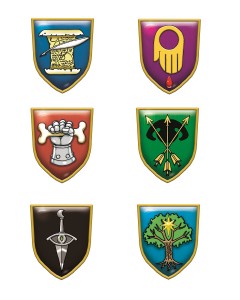
Designing the callings for Pugmire, Monarchies of Mau, and Pirates of Pugmire was an interesting challenge. My goal with the games was to be a nostalgic reinvention of classic fantasy gaming, so some form of “class” was necessary. But I also wanted them to be evocative of this new world I was creating.
Early on, I decided a couple ground rules:
- Each calling would key off two attributes. It would have been easy to tie each calling to one primary attribute, but I felt two gave each calling more depth. Since tricks are picked and refined by player choice instead of a built-in progression, it meant that following one of two rough “paths” could lead to different expressions of the same core calling idea.
- I wanted six in each core rulebook. Not only did this pair well with the six attributes, but six is generally the number of players I have in my games. I wanted each player to have the opportunity to play something cool.
Let’s look at how well I did!
Pugmire was the first book, and at the time possibly the only book, so I had to get the core concepts down the first time.
- Artisans (Charisma and Intelligence): One of the more radical callings in the book, I wanted magic users that were more like a blend of charismatic sorcerers and classic mages. I felt the stereotype of the “loner magician” worked better for cats, so even though I wasn’t 100% sure I would ever do a cat game, I still wanted the dogs to have something different.
- Guardians (Charisma and Strength): I struggled with this for a while. Originally they were going to be more like paladins, but that felt too close to Shepherds. Then I was going to make them a lot like generic warriors, but that actually got too close in gameplay to Strays. I settled on charismatic warriors: warlords, leaders, and ideologues. That felt more like a “guardian” to me.
- Hunters (Dexterity and Wisdom): Hunters were one of the first callings I knew right away how they would be structured. I definitely wanted room for dogs that travel in the woods and hunt things, although I tweaked the flavor to “hunt monsters” to make them more explicitly heroic. They’re really close to rangers, but in this case it worked so well I didn’t mess with the formula much.
- Ratters (Constitution and Dexterity): This one I probably fiddled with the longest. I struggled to figure out how “thief” worked in the setting I was building. It wasn’t until I stumbled on the concept of rat-hunting dogs and merged that with a kind of Gray Mouser antihero that I was able to nail this down. But even then, I wanted these to be hardier than the average thief, which is why I swapped Constitution in. It’s definitely a calling that feels stereotypical at first, but you find the depth and nuance as you play it.
- Shepherds (Intelligence and Wisdom): This was another calling that I knew pretty might right away how I wanted it to land. It’s a monotheistic cleric, essentially, with a dash of magical knowledge. I gave them a little more combat capacity, since I took away the “paladin bits” from Guardians, but otherwise they were easy to work out.
- Strays (Constitution and Strength): This one had a good concept right away (although they had the name “pariahs” for a long time), but it evolved as I worked on the game design. Mechanically it fills the needed role of strong, tough warrior that the callings needed, but most of the other tricks were geared around helping other dogs in the party. Thematically, strays help themselves, so it took a while to make the mechanics work so the gameplay of the calling still landed right, but they still had incentives to help the rest of the party out.
Next time, I’ll go into Monarchies of Mau!
